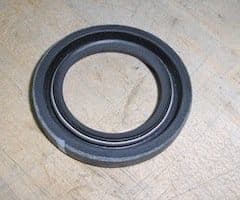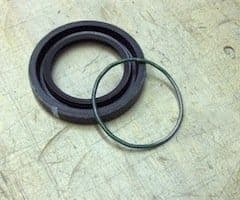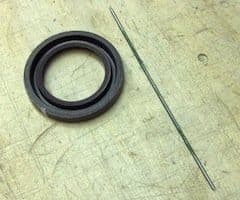
Curated with aloha by
Ted Mooney, P.E. RET

The authoritative public forum
for Metal Finishing 1989-2025

-----
Can type 316 stainless steel become magnetic?
Q. I have been using some type 316 stainless steel threaded pipe fittings in a system containing sulfuric acid. A city inspector came to my site and put a magnet up to the pipe fittings and it stuck. Although the fittings had type 316 cast into the body, he stated that they could not be stainless steel because they are magnetic. I have been told that the machining of the fittings, such as cutting the threads, can cause them to become magnetic. Is this true, and if so where can I find something in writing to show the inspector ?
Thank you,
David Hathaway- Pico Rivera, California, USA
2001
A. We've seen this question in this forum before [letters 7136, 21171 ... ].
Type 316 stainless can be made magnetic by working the metal.
George Brackett III- Utica, New York
2001
2001
A. Hello David!
The magnet test is usually a good one, as it is necessary to impart enough work into the steel to get it to change the arrangement of the atoms to get ferromagnetic properties. (You got to go from the standard face centered cubic to a body centered tetragonal pattern.) It hasn't been my experience that this happens with mere machining in 316- I've always had to get cold rolling, or bending, or some sort of forming to get the magnet to stick. Some of the things that could affect this include composition- higher chromium, carbon, or molybdenum contents, or lower nickel contents, will make the transformation occur a lower amounts of cold work. Perhaps your casting is a bit off in composition?
Is it as magnetic even away from the cut threads?
Regarding references, I oddly enough don't find anything in the Mil Handbook on this, and while there is likely something in one of the many publications the Nickel Development Institute offers, I can't guarantee it without spending some time searching (but be sure to pick up your free copy of #9014!) .
So, I'll recommend what Peter Moore of Atlas Steels in Australia has put together: a nice handbook on stainless steels, at
www.atlas-steels.com.au/techinfo/
www.atlassteels.com.au/site/pages/technical-handbooks-of-stainless-steel.php
[link updated by editor Dec. 2013].
There's a section in the Technical Handbook on magnetic properties you might find interesting.
Good luck!

Lee Gearhart
metallurgist - E. Aurora, New York
A. David,
I thought that 316 was non-magnetic (strictly speaking a magnetometer is influenced by 316!) but that the 400 series, which had more iron, is magnetic...but how magnetic it is, I don't know ...
However, if your acid concentration of sulfuric is fairly high,(say 90% or more) then even Iron or any grade of stainless @ R.T. should be OK. And if that is so, tell that inspector to go take a running jump!
It would have been more helpful if you had mentioned the concentration & the temperature.
Mind you, PVC is better than 316 stainless and can take any concentration of sulfuric up to 93% commercial... but there are other and better plastics which cost far more if you wanted a higher temperature resistance.

Freeman Newton [deceased]
(It is our sad duty to advise that Freeman passed away
April 21, 2012. R.I.P. old friend).
2001
2001
A. The key to the answer is that the fittings are said to be castings. Stainless steel meeting "316" is actually a rolled or forged material but the name is used for shorthand even for castings. The "equivalent" casting specification is CF-8M, which is similar but not identical in composition and properties. So why is it magnetic? When cast, steels similar to 304 and 316 stainless have small amounts of the magnetic phase referred to as ferrite in the microstructure. (Welds used for these materials also have small amounts of ferrite.) Depending on the amount of ferrite, stainless castings vary from slightly to substantially magnetic. If you compare the pull of the magnet to something that is fully magnetic, such as 400 series stainless or carbon steel, you'll see a big difference, since the ferrite amount in the casting is only between 5 and 25 percent.
Any textbook on stainless castings will explain this. Few Web pages go into this sort of detail, but I found a description at
www.sfsa.org/sfsa/pubs/cvf/ecs.html
--the Steel Founder's Society of America, that at least documents it in relatively simple language. All you have to know is that the ferrite is the magnetic portion.

Paul Tibbals, P.E.
gas & electric
San Ramon, California, USA
(My opinions are not related to nor a statement of my employer's)
A. Lee: The casting composition would be a bit off typical if the casting was NOT slightly magnetic.
Paul: Well stated.
316 for wrought product has its chemistry balanced so that it is fully austenitic (and hence incidentally nonmagnetic) because that microstructure requires least power when rolling the steel into bar/sheet/rod/whatever, whether that rolling is being done hot or cold.
CF-8M for castings has its chemistry balanced so that it is predominantly austenite with usually 5 to 15 percent ferrite. This is done to enhance hot strength and reduce the possibility of complex cast shapes tearing as they cool in the mold. Since the casting isn't going to be rolled, the increased hot strength doesn't cause any inconvenience. The increase in strength is maintained down to room temperature.
A beneficial side effect is that the ferrite in CF-8M is induced by use of higher chromium content than is used in 316 (usually 18-19 percent for CF-8M against 17-17.5 for 316) and this gives the casting grade better resistance to general corrosion as well as to pitting corrosion.
If CF-8M castings are required to be nonmagnetic, they can be made so, by using a different balance of the constituent elements while still holding each element within its specified range. For instance, CF-8M or any other stainless grade which is for components to be used on pot lines in an aluminium smelter, are made nonmagnetic so that they are not attracted to the potline busbars that are carrying massive electric currents and thus generating massive magnetic attractions. But where CF-8M castings are required to be nonmagnetic, the purchaser/specifier MUST SAY SO otherwise the foundry steelmaker will normally choose to have a few percent ferrite present.
As Paul notes, it is regrettable that many design engineers call up 316 for castings. Castings made to the typical wrought 316 chemical composition have corrosion resistance and mechanical properties that are inferior to those made to the typical casting CF-8M chemical composition.

Bill Reynolds [deceased]
consultant metallurgist - Ballarat, Victoria, Australia
We sadly relate the news that Bill passed away on Jan. 29, 2010.
2001
A. I have recently experienced that Stainless does not mean non magnetic. In my case it is very important the material in the component is non magnetic since I am using it in a particle detector with a magnetic field of max 4 Tesla.
I suggest that you take a look at this address for a excellent explanation:
www.physlink.com/Education/AskExperts/ae546.cfm
Best regards,
Lasse IsaksenCERN - Geneva, Switzerland
2003
2004
A. I found this information helpful:
Background:
Magnetic permeability is the ability of a material to carry magnetism, indicated by the degree to which it is attracted to a magnet. All stainless steels, with the exception of the austenitic group, are strongly attracted to a magnet.
Austenitic Grades:
All austenitic grades have very low magnetic permeabilities and hence show almost no response to a magnet when in the annealed condition; the situation is, however, far less clear when these steels have been cold worked by wire drawing, rolling or even centerless grinding, shot blasting or heavy polishing. After substantial cold working Grade 304 may exhibit quite strong response to a magnet, whereas Grades 310 and 316 will in most instances still be almost totally non-responsive. The change in magnetic response is due to atomic lattice straining and formation of martensite. In general, the higher the nickel to chromium ratio the more stable is the austenitic structure and the less magnetic response that will be induced by cold work. Magnetic response can therefore be used as a method for sorting grades of stainless steel, but considerable caution needs to be exercised.
Stress Relieving:
Any austenitic (300 series) stainless steel which has developed magnetic response due to cold work can be returned to a non-magnetic condition by stress relieving. In general this can be readily achieved by briefly heating to approximately 700 - 800 °C (this can be conveniently carried out by careful use of an oxy-acetylene torch). Note, however, unless the steel is a stabilized grade it could become sensitized to carbide precipitation. Full solution treatment at 1000 - 1150 °C will remove all magnetic response without danger of reduced corrosion resistance due to carbides. If magnetic permeability is a factor of design or is incorporated into a specification, this should be clearly indicated when purchasing the stainless steel from a supplier.
Cold Working:
Many cold drawn and/or polished bars have a noticeable amount of magnetism as a result of the previous cold work. This is particularly the case with grades 304 and 303, and much less so for the higher nickel grades such as 310 and 316. Even within the chemical limitations of a single standard analysis range there can be a pronounced variation in the rate of inducement of magnetic response from cold work.
Magnetically Soft Stainless Steels:
In some applications there is a requirement for a steel to be "magnetically soft". This is often required for solenoid shafts, where it is necessary for the plunger to respond efficiently to the magnetic field from the surrounding coil when the current is switched on, but when the current is switched off the magnetic field induced in the steel must quickly collapse, allowing the plunger to return to its original position. Steels which behave in this way are said to be magnetically soft. For corrosion resisting applications there are ferritic stainless steels which are magnetically soft, usually variants of a grade "18/2" (18% chromium and 2% molybdenum) but with very tightly controlled additions of silicon and often with sulfur added to make them free machining. Special mill processing guarantees the magnetic properties of the steels.
Source: Atlas Steels Australia
Robert Cullen- Milford, New Hampshire
A. This is an age old question. The reasons are that cold working of AISI316 can produce the martensitic phase in the asutenite matrix, known as epsilon martensite, which of course is magnetic. But mere thread cutting will not produce this degree of cold work although thread rolling instead of cutting could. Its a case of ascertaining if it was thread cut or rolled. Also casting grades are usually inferior in key elements to forming grades, to assist with casting, so a good solution is to use thread cut formed tube 316 rather than cast 316. I have been involved in many years of applications of these materials into power stations cooling systems, gas pipelines systems, hot water systems and domestic products in solar technology; and I have witnessed the inferior performance of cast 316 in warm applications in regard to corrosion resistance. I would not use the casting alloys in such applications.
Geoff C GraceGeoff Grace Contract Consulting - Bundoora, Victoria, Australia
December 18, 2013
Q. I am checking some screws that are 316 or equivalent Stainless Steel. Someone checked them with a magnet and assumed they are steel rather than stainless steel because they are magnetic. Is this necessarily true?
Thanks!
Quality Inspector - Elwood, Indiana, USA
2007
A. Such things can be determined at a cost, Mark. There are costly (about $40K) hand-held X-ray fluorescence machines called alloy sorter / scrap sorter ⇦ this on eBay or Amazon [affil links] which will almost instantly identify the alloy in complete detail.
But as for the most likely scenario, I'd say the screws are probably stainless but not 316 -- perhaps 4xx series. Good luck.

Ted Mooney, P.E. RET
Striving to live Aloha
finishing.com - Pine Beach, New Jersey
2007
A. The chemical spot test method is inexpensive and effective at determining stainless steel 316. Spot test kits are available and more reliable than magnetic properties because alterations in the physical properties will not effect composition of the alloy. The Moly Test is such a test for verifying stainless steel 316.
Wolf KoslowKoslow Scientific Company
Englewood, New Jersey

June 22, 2010
A. Nowadays some companies decrease Ni and increase Mn content of austenitic stainless steels to make them cheaper! Mn, like Ni, is a austenite stabilizer meaning that we can maintain austenite phase stable in room temperature with cheaper-Mn instead of expensive Ni.
Refer to austenitic stainless steels standards (like Russian GOST standards for 08X18H10T, e.g.,. AISI 321), the ferrite content up to 10% is permissible. Up to this ferrite content there is no severe change in corrosion properties of stainless steel specially general corrosion behavior, but in more ferrite content, the stainless steels may be susceptible to intergranular corrosion (depends on environment).
Ok, Ideally the 300 series stainless steels shall not show any magnetic properties BUT practically the magnetic properties of 300 series are not so uncommon!
- University of Tehran, Iran
January 29, 2009
Q.
1. Please how can I identify an original stainless steel pipe and fittings.
2. And how can I identify a 316 stainless steel pipe and fittings
buyer - port harcourt, Nigeria
July 6, 2011
A. Hi, Alex.
You may know something that I don't, but as far as I know there is no accepted meaning for "original" stainless.
X-ray fluorescence can determine the type of stainless steel exactly, but the equipment is expensive. A spot test was previously mentioned by Wolf Koslow. Good luck.
Regards,

Ted Mooney, P.E. RET
Striving to live Aloha
finishing.com - Pine Beach, New Jersey
July 7, 2011
Q. Hello My name is Tom Winter. We have a customer is Taiwan with a problem with 316 stainless steel corrosion on 316 bolts and pipe hangers, castings. They are corroding, probably due to sea air. They are exposed. They don't they they are stainless steel because they are magnetic, but their vender assures them they are 316. Could the corrosion form the salts turn the 316 magnetic? I have heard that work hardening can make 316 become magnetic. Anyone have have any experience with this? Thanks
Tom WinterWe process tubing and fittings - St. Louis, Missouri, USA
September 12, 2011
A. Cast 316 material is more magnetic than other forms, as explained in numerous material texts. Regardless of the ferrite content, stainless steel can corrode if exposed to the right conditions. We see it with 316L and in super duplex which have different ferrite contents. Salt air will definitely contribute to corrosion. I don't know if salt would make it more magnetic. Either way, we prevent corrosion (or significantly delay it) in our marine applications by either painting our SS products or electropolishing them. A reduction in surface roughness vastly increases the ability of material to withstand corrosion.
A positive material identification (PMI) test can be performed to determine various types of steel. We use it to distinguish between 316L and 304 grades of stainless.
I'm sure the equipment is expensive, but I've also seen companies that rent or lease it. Alternatively, find a test lab that makes house calls.
Hope this helps!
Mathew Heidmous- Boulder, Colorado, US
September 20, 2011
A. The reference you are looking for is in "Metals Handbook" (c) 1985 published by the American Society for Metals.
Peter Orr- Colorado Springs, Colorado, USA
November 8, 2011
July 6, 2012
Q. Our company uses transmission oil seals (lip seals) in its marine products. We have used the same supplier for nearly 20 years. Upon receipt of these lip seals, our staff removes each 316 stainless steel garter spring from the lip seal. We inspect spring length and general condition. In addition, we pass a magnet over each spring.
Recently, these 316 stainless springs began to stick firmly to our magnet.
Our product (containing these lip seals) operates in salt water. In an effort to reduce the effects of corrosion and electrolysis, we have requested 316 stainless from our vendor for years.
My concern is that they now receive these springs from a different supplier and the quality of the stainless has diminished.
Heating the springs to 700-800 °C is not possible.
We do have other SS parts passivated (locally) before putting into inventory. Would passivation eliminate some / all of this increase in magnetic characteristics?
Any other suggestions?



Thanks.
- Deerfield Beach, Florida, USA
A. Jeff,
I very much doubt that passivation would affect the magnetism, it's just a surface treatment. There are ways that normally non-magnetic stainless grades can end up magnetic, but I would also worry that your 316 is not up to par.

Ray Kremer
Stellar Solutions, Inc.
McHenry, Illinois

A. Degaussing is the process that you are looking for. Follow the instructions to the letter or you could make the problem worse rather than better. Do frequent checks on the product that the floor produces. It can go south easily.
James Watts- Navarre, Florida
August 14, 2012
June 2015
Hi James. Yes, degaussing can certainly remove magnetism (the piece will no longer act as a magnet and attract steel to itself) but I'm not so sure it does anything to correct a piece of stainless steel that has become ferromagnetic (the stainless steel being attracted by a magnet). It clearly doesn't remove ferromagnetism from steel parts.
Regards,

Ted Mooney, P.E. RET
Striving to live Aloha
finishing.com - Pine Beach, New Jersey
A. If you are looking for 316 Non Magnetic then you need to be ordering 316 to the AMS5360 spec which does not overlap with the normal 316/316L grades. AMS5360 has lower chrome and higher nickel. This is what I sell to my aerospace accounts and other industry foundries requiring a truly non magnetic 316 alloy.
Rod Guyton- Torrance, California, USA
October 16, 2012
Q. Dear Sir,
Very recently I have taken a 8" dia. stainless steel weir strainer sample. It's attracted by magnet; and then I sank the sample into 33% hydrochloric acid (commercial) solution. I have seen after 48 hours, the stainless steel became highly colorless & severely corroded.
In these circumstances, let me know, is the stainless steel sample pure stainless steel? And why has it has severely corroded? And how can be tested for justification as a pure stainless steel.
Your early response will be highly appreciated.
Thanks
Tapash
- Narayangonj, Dhaka, BANGLADESH
February 24, 2013
A. Hi Tapash. "Stainless steel" describes dozens or hundreds of different steel alloys which are somewhat corrosion resistant. Most are alloys of steel with chromium, often with nickel, and smaller amounts of other materials like molybdenum. Some are strongly magnetic, some are non-magnetic. But very few stainless steels could be expected to stand up to 33% hydrochloric acid.
Regards,

Ted Mooney, P.E. RET
Striving to live Aloha
finishing.com - Pine Beach, New Jersey
February 24, 2013
Q. Hello
What is the way to return the non-magnetic feature of 316 stainless steel?
I have stainless steel sheet (specification 1.4571 - 3.00 mm - 1D) that has been prepared. But after cutting by laser the anti-magnetic feature is somewhat lost. What do you suggest?
- MAZANDARAN,IRAN
June 10, 2015
How to tell if 316SS material is a casting or not?
Q. How can I tell the manufacturing process of SS316 material, we are trying to determine if it is cast material or not?
We did micro assessment and it revealed a non-twinned grain structure, however hardness was fine and chemical analysis was within range (with no extra carbon detected)
- dubai, uae
November 1, 2015
![]() Hi David. Why does it matter? I'm not implying that it doesn't matter; rather, I'm saying that knowing why it matters can sometimes suggest an easier, better, or more direct test.
Hi David. Why does it matter? I'm not implying that it doesn't matter; rather, I'm saying that knowing why it matters can sometimes suggest an easier, better, or more direct test.
Generally, things are cast only when that's the most practical way to obtain the desired shape; so sometimes just looking at it will give you 90% odds how it was made. If it looks like a casting, it almost surely is; if it doesn't look like a casting, it probably isn't :-)
Regards,

Ted Mooney, P.E. RET
Striving to live Aloha
finishing.com - Pine Beach, New Jersey
November 2015
Q. Hi,
Thanks for the reply.
The reason it matters is my client specifically asked their provider to ensure that product was not made from cast material. Now it's difficult to assess as the component is fully machined, but on one section the material looked cast. The manufacturer claims that this was due to shot/sand blasting of the material to aid machining.
This is why the question was asked.
Hence we did the assessments available to us and I'm left with the results published on my original post.
- dubai, uae
November 3, 2015
Q, A, or Comment on THIS thread -or- Start a NEW Thread


